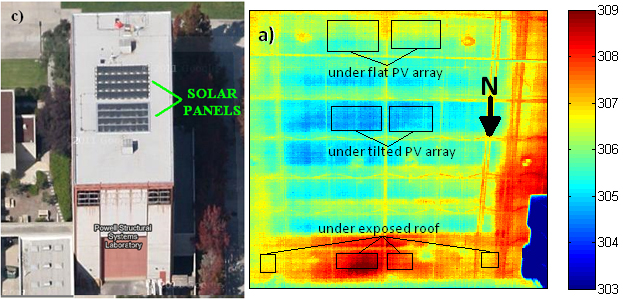Solar panels keep buildings cool, study shows

It turns out that solar photovoltaic panels installed on rooftops do more than supply clean power, they also act as "roof shades" to keep buildings cool, according to a team of researchers at the UC San Diego Jacobs School of Engineering.
The researchers used data gathered from thermal imaging to determine that during the day, a building's ceiling (in this case the school's Powell Structural Systems Laboratory) was 5 degrees Fahrenheit cooler under solar panels than under an exposed roof. And at night, the panels provide thermal insulation to hold heat in, reducing heating costs in the winter.
On the left in the image above is a Google Earth image of the Powell Structural Systems Laboratory. It has a tilted solar panel array on the north side and a flush solar panel array on the center of the roof. On the right is a thermal infrared image of the rooftop of the same building. The color bar shows temperatures in degrees Kelvin. The footprint of the tilted solar panel array is visible as a cool area in the center of the image.
The UC San Diego team, led by Jan Kleissl, a professor of environmental engineering, calculated that the amount saved on cooling the building was equal to getting a 5 percent discount on the solar panels’ price, over the panels’ lifetime.
“Talk about positive side-effects,” said Kleissl in a news release.
The reasoning behind this effect is straightforward. The panels bear the brunt of the sun's beating rather than the roof, which would normally allow the heat to penetrate through and inside the ceiling of the building. Additionally, blowing wind removes much of the heat in the space between the panels and the roof, therefore, tilted panels provide more cooling benefit.
Also, said Kleissl, the more efficient the solar panels, the bigger the cooling effect. For the Powell Structural Systems Laboratory, the panels reduced the amount of heat reaching the building's roof by about 38 percent.
“There are more efficient ways to passively cool buildings, such as reflective roof membranes,” said Kleissl. “But, if you are considering installing solar photovoltaic, depending on your roof thermal properties, you can expect a large reduction in the amount of energy you use to cool your residence or business.”
These findings could help give the solar industry a much needed nudge. Solar power penetration among U.S. residences stands currently at 0.2 percent (130,000) of U.S. homes, according to experts.
The UC San Diego study will appear in an upcoming issue of the journal Solar Energy.
Related:
Giant futuristic batteries to power 2,000 households
